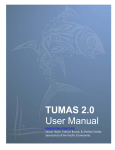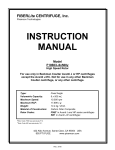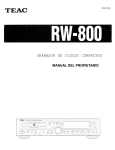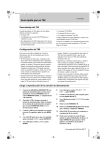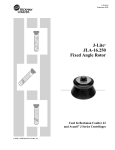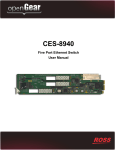Download Tascam RC-828 User's Manual
Transcript
Section 1 – Starting to use the RC-828 1 – Starting to use the RC-828 The TASCAM RC-828 Remote Control Unit allows you to control up to 4 DTRS1 recorders (any combination of DA-98, DA-38 or DA-98 units) from one location. The functions which may be controlled are: • Transport operations (including jog and shuttle) • Track arming • Auto punch operations • Chasing control • Location memories and auto-repeat between two points This manual makes reference to the manuals of the following units: DA-88, DA-38, DA-98 and SY-88. Please consult these documents as necessary when setting up and using the RC-828. 1.1 Hooking up the RC-828 The RC-828 and DTRS units form a “daisychain”, with the RC-828 being at the head, and the “tail” unit being terminated with the terminator supplied with the RC-828. The RC-828’s REC FUNCTION keys 1 through 8 now control the first unit, Keys 9 through 16 control the next unit in the chain, and so on (regardless of the actual Machine IDs of the units). Tighten the screws holding the cable connector to the RC-828 and to the DTRS unit. This will prevent accidental disconnection of the RC-828 in the middle of a session. WARNING Use only TASCAM cables to connect the RC-828 to the first DTRS unit, and to connect the DTRS units to each other. If the use of cables other than TASCAM cables causes or results in damage to the units, the warranty is voided. No power connection is needed for the RC-828. All power for LEDs, etc. is supplied by the first DTRS unit. NOTE At least one LED is always lit on the RC-828 when it is connected and power is switched on to the DTRS units. If you do not see any lit LEDs on the RC-828, make sure the DTRS power is switched on, and check the cable connections to the RC-828. 1.1.1 Machine IDs A DA-88 uses a rotary switch to set the ID and uses 0 as the lowest ID, and a DA-38 or DA-98 uses software to make this setting, and uses 1 as the lowest ID. Refer to the units’ manuals for full details of setting the ID. Unit RC-828 OUT DA-98 IN Cable supplied with RC-828 DA-88 DA-38 OUT IN OUT IN PW-88S PW-88S Terminator DA-98 1 1 DA-88 0 1 DA-38 1 1 WARNING Turn off power to all units when making connections. If you do not do this, there is a possibility that the RC-828 will malfunction or even be damaged. 1 How the ID is set (see the unit’s manual for details) Power on or off when ID is set Use the suppled cable to connect the RC-828 to the REMOTE IN/SYNC IN of the first DTRS unit, and a PW-88S cable to connect the SYNC OUT of the first unit to the REMOTE IN/SYNC IN of the next unit, and so on, until the terminator is connected to the SYNC OUT of the last unit in the chain. Set the machine IDs of the DTRS units so that the IDs run in a sequence from the unit at the “head” of the chain, closest to the RC-828 (lowest possible ID) to the “tail” unit (highest ID). There should be no gaps in this sequence. “Real” ID When you connect a number of DTRS units which are of different types, including a DA-98, the DA-98 should be at the head of the chain immediately following the RC-828. Other units may then be connected in any order. If the DTRS units are DA-88s and DA-38s only, they may be connected in any order. ID as shown NOTE ON Menu system (see 9.2) OFF Rotary switch on rear panel (see p23– 24) Tape counter menu ON system (see 7-2) DTRS is a trademark of TEAC Corporation 0.98 – 1 Section 2 – Parts of the RC-828 to the RC-828 in the same way as the CHASE keys and indicators on the units themselves. NOTE When you set the machine IDs, you can set the ID of any machine first, but we recommend doing this in a standard sequence, working from the head of the chain to the tail. [4] 1.1.2 Chase mode In an all-audio setup, the first unit is unlikely to be chasing external sources. However, subsequent units in the chain should now chase this master, using the DTRS (ABS) sync method, when their CHASE switches are pressed. DA-98 9.2.3 Reference DA-38 DA-88 7-3 p. 24 DA-98 7.1.1 SY-88 Reference DA-38 DA-88 — — SY-88 5-1 2 – Parts of the RC-828 [5] REMOTE connector Connect one end of the supplied cable to this connector, and the other end to the first DTRS unit, as described in 1.1, “Hooking up the RC-828”. Make sure the power to the DTRS unit is turned off when you make the connection. [2] REC FUNCTION keys and indicators The 32 REC FUNCTION keys allow you to arm the tracks of up to four DTRS units. Keys 1–8 control the tracks of the first unit in the chain, 9– 16 those of the second, and so on. Pressing keys which correspond to a non-existent DTRS unit will have no effect. Pressing the corresponding keys on the DTRS units has the same effect as pressing the keys on the RC-828 unit (i.e. if the track is not armed, it will now be armed, and vice versa). The indicators flash when a track is armed for recording, and light solidly when recording is being rehearsed or taking place. [3] CHASE keys and indicators These keys and indicators allow you to set and view the chase status of the DTRS units connected 2 – 0.98 SY-88 — If you want to monitor using confidence mode on a DA-98 unit, make sure that the ALL INPUT key is off and use the INPUT MONITOR keys on the DA-98 to turn off input monitoring on all tracks. In this case, you should take care to set the clock reference of the master DTRS unit appropriately. [1] Reference DA-38 DA-88 9.1 (1) p. 9 (18) The INPUT MONITOR keys on the DA-98 also affect the switching between source and tape. Using the RC-828 REC FUNCTION keys to change the status of any tracks while the ALL INPUT function is on will lose the relationship between the REC FUNCTION and INPUT MONITOR status for individual tracks when ALL INPUT is turned off again. Start recording or reset the REC FUNCTION keys to restore this. — However, in some audio setups or an audio-visual setup, it may be necessary to make the master DTRS unit slave to incoming timecode: DA-98 10.7.1 ALL INPUT key and indicator This key performs the same function as the ALL INPUT key on a DTRS unit, switching the monitoring of all tracks on all connected units to the input source. The indicator lights when this mode is active. AUTO MON key This key is equivalent to the AUTO MON key on the DA-98 and performs the same function as this key on any connected DA-98 units. There is no key with the same name on the DA-38 or DA-88; pressing this key is the equivalent of pressing the INSERT key on a connected DA-38, and pressing both the AUTO INPUT and INSERT keys on a DA-88. It is used in punch modes to switch automatically between tape and source when punching in and out automatically. The indicator lights when this function is active. Note that the status of the INPUT MONITOR keys on a DA-98 will be overridden by the AUTO MON key. However, when AUTO MON is turned off again, the original status of these keys will be restored. Using the RC-828 REC FUNCTION keys to change the status of DA-98 tracks while AUTO MON is on will lose the relationship between the REC FUNCTION and INPUT MONITOR status for individual tracks when AUTO MON is turned off again. Start recording or re-set the REC FUNCTION keys to restore this. If you want to monitor using confidence mode on a DA-98 unit, make sure that the AUTO MON key Section 2 – Parts of the RC-828 is off and use the INPUT MONITOR keys on the DA-98 to turn off input monitoring on all tracks. the DTRS unit’s current time reference (ABS or timecode). NOTE [6] JOG/SHTL MON key and indicator This key allows the selection of different monitoring modes when shuttle mode is selected, either with the units’ own SHUTTLE controls, or from the JOG/SHUTTLE key on the RC-828 [15]. This key and indicator duplicate the function of the SHTL MON key and indicator of the DA-98, and provide these capabilities for the DA-38 and DA-98. Use the flowchart provided with this manual to check the shuttle monitoring status of DA-38 and DA-88 units in different modes (the provision of confidence mode on the DA-98 means that this model differs from the others), and you should also consult the manual of the DTRS unit for full details, if you are unclear about how shuttle monitoring works: DA-98 7.1.3 [7] Reference DA-38 DA-88 — — SY-88 — These location memories are independent of the MEMO 1 and 2 location memories stored in the DTRS units. The indicator of a location memory containing a location point will be lit, and pressing the key (except in “capture” or erase mode, see [11] and [12]) will locate to the point stored in that memory. Pressing a key whose indicator is not lit will have no effect. The location point stored in the memory will be briefly shown on the tape counter of the DTRS units (for the DA-88 and DA-38–for the DA-98 the location point will be shown briefly on the LCD display screen). While location is taking place, the indicator will flash, and the indicator will light steadily again when location is complete. If the AUTO PLAY indicator [13] is lit, the DTRS unit will start to play back when the location point is reached, otherwise the transport will stop at the location point. NOTE RHSL key This key duplicates the functions of the corresponding key controlling rehearsal operations on the DTRS units. See the appropriate section of the DTRS manual if you are unsure of its operation. DA-98 6.6 Reference DA-38 DA-88 4-3 p. 16 SY-88 The location points are stored in memory, backed up by a battery whose life is a few years. When you turn on the DTRS unit connected to the RC-828 with location memories stored in it, the same location indicators will light as were lit at the time when you last turned off the DTRS unit. If they do not light, the battery needs replacing, and you should contact your TASCAM dealer regarding a replacement battery. — [11] [8] AUTO PUNCH key This key duplicates the functions of the corresponding key controlling auto punch operations on the DTRS units. See the appropriate section of the DTRS manual if you are unsure of its operation. [9] CLEAR key This key duplicates the functions of the corresponding key clearing punch points on the DTRS units. See the appropriate section of the DTRS manual if you are unsure of its operation. [10] LOCATE POINTS 1–12 These 12 location keys and indicators are used for the management of location memories. These memories are stored and used with reference to CAPTURE key and indicator Press this key to enter “capture” mode. The green indicator will flash. While in capture mode, pressing a LOCATE POINT key [10] will store the current tape position to the location memory corresponding to the LOCATE POINT key. If the memory does not contain data (the indicator is not lit), the new position will be written to the memory and the indicator will light. If the memory already contains a location point (the indicator is lit), this will be overwritten with the new position. Press the CAPTURE key again to turn off the capture mode (the indicator will stop flashing). [12] ERASE key To erase a location memory, press and hold down the ERASE key. While holding it down, press the LOCATE POINT key [10] of the memory you want to erase. The indicator of the LOCATE 0.98 – 3 Section 3 – Monitoring modes POINT key will go out. Pressing and holding the ERASE key while pressing a LOCATE POINT key where no location point is stored (the indicator is unlit) will have no effect. AUTO MON key [5], be regarded as the same control), this key and indicator behave differently. • To erase all location point memories, press and hold down the ERASE key, and press the CAPTURE key. [13] AUTO PLAY key and indicator Turn on “auto play” mode by pressing this key (the indicator will light). The DTRS unit(s) connected to the RC-828 will now start playing back when a location point accessed through the LOCATE POINT keys [10] is reached. • • If “auto mode” is off (the indicator is off), the DTRS units will stop when the location point is reached. [14] [16] REPEAT key and indicator This key and indicator duplicate the functions of the corresponding keys on the DTRS units. The first repeat point is stored in location memory 11, and the second repeat point in location memory 12 (though memory 12 can be earlier than memory 11). These repeat points are independent of the repeat points stored in the DTRS units. If these two points are less than five seconds apart, repeat play is not possible. See the following sections of the manuals for operation of the repeat mode. DA-98 8.2.5 [15] Reference DA-38 DA-88 5-5 p. 22 SY-88 — JOG dial/SHUTTLE wheel, key and indicator Pressing the JOG/SHUTTLE key on the RC828, or the SHUTTLE key on the first DTRS unit will enable the control on that unit. The indicator will light steadily, and the light on the other unit will flash. Pressing the shuttling key on a unit where the indicator is flashing will enable the shuttling control on that unit and the indicator will light steadily. The steadily-lit indicator on the other unit will start to flash, and the shuttling control will be disabled. Pressing the shuttling key on the unit where the indicator is steadily lit will turn off the indicator on that unit, and the unit where the indicator is flashing. The shuttling controls of both units will now be disabled. Transport controls These transport controls duplicate the transport controls on the first DTRS unit at the “head” of the chain. Subsequent machines in the chain must be controlled by chasing the first unit (see 1.1.2, “Chase mode”). However, if the first unit is chasing to timecode, pressing the FF and REW keys of the RC-828 will have no effect. The JOG/SHUTTLE controls [15] are also disabled. See the DTRS units’ manuals for details of the transport keys: DA-98 2 [32]–[36] Reference DA-38 DA-88 2 [7]–[11] p.10 26 – 30 SY-88 — 3 – Monitoring modes DTRS units are provided with a SHUTTLE control, allowing variable speed cueing to emulate “rock and roll” editing on open-reel machines. The supplied charts allow you to see what monitoring mode is in operation on a particular track or tracks, depending on the status of the DTRS units. The RC-828 allows this function to be carried out remotely, and also provides a jog dial, allowing precise cueing to frame accuracy. See the DTRS manuals for full details of monitoring modes: The monitoring in these modes is determined by a combination of factors, including the JOG/SHTL MON key [6]. See the flowchart in this manual for further details. DA-98 7.1.2 An important point to note is that, while most of the RC-828 controls can be used alongside the corresponding controls on the DTRS units (i.e. they can, with a few exceptions, such as the 4 – 0.98 Reference DA-38 DA-88 SY-88 9-1 (2) p. 10 (19, 20) — Specifications 4 – Specifications Maximum number of DTRS units 4 that may be controlled simultaneously REC FUNCTION controls for 32 tracks individual track arming Location memories 12 location memories (11 and 12 may be used as repeat points) Shuttle speeds (forward and x 8, 4, 2, 1, 1/2, 1/4 reverse) normal speeda Power supply From master DTRS unit Overall dimensions (w x d x h) 250 x 200 x 58 mm (9.8 x 7.9 x 2.3 in.) Weight 1.2 kg (2.6 lbs) a. 1x speed is only available in forward shuttle mode Monitoring flowchart Monitoring flowchart What do I listen to ? ALL INPUT ? REC FUNCTION ? MUTE Note: • • “Y” = [on/yes] “N” = [off/no] STOP FF, REW ? AUTO MON ? JOG/ SHUTTLE ? PLAY ? AUTO MON ? JOG/ SHUTTLE ? SHTL MON ? SHTL MON ? TAPE SOURCE Monitoring tables Monitoring tables DA-88 and DA-38 PLAY REC ALL INPUT on AUTO MON off ALL INPUT off AUTO MON on REC FUNCTION off REC FUNCTION off JOG/ SHUTTLE Source REC FUNCTION on REC FUNCTION on STOP, FF. REW Tape Tape Tape Tape Source Tape Mute Source Mute Tape See below DA-88 and DA-38 shuttle modes (ALL INPUT off, AUTO MON on) JOG/SHUTTLE Tape REC FUNCTION on Source JOG/SHTL MON on REC FUNCTION off Mute JOG/ SHTL MON off DA-98 PLAY ALL INPUT on AUTO MON off ALL INPUT off AUTO MON on REC FUNCTION on Selectablea REC FUNCTION off REC FUNCTION on REC FUNCTION off Tape STOP, FF. REW Source Source Selectable Selectableb Source Source b Selectable REC JOG/ SHUTTLE Selectableb See belowbc a. “Selectable” means that confidence mode can be used here b. When the shuttle mute function is active (see 8.6.2 in the DA-98 manual), output is muted in these modes c. When shuttle monitoring is turned off here, monitoring is off-tape, and when it is turned on, the input source is monitored








